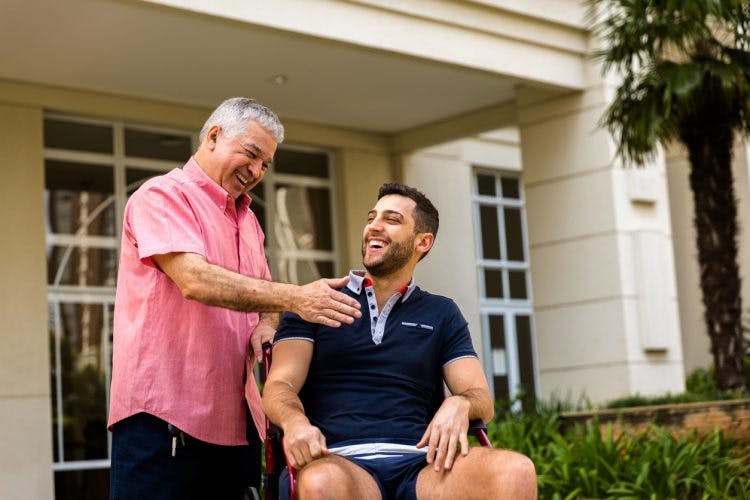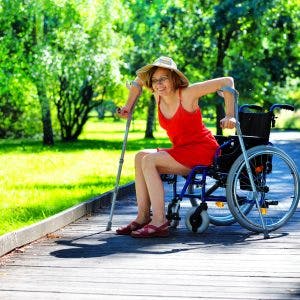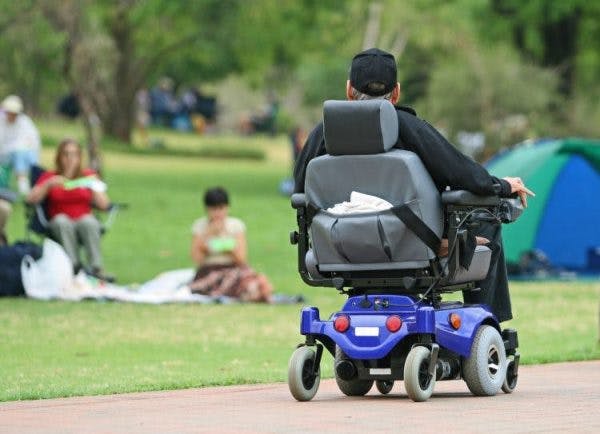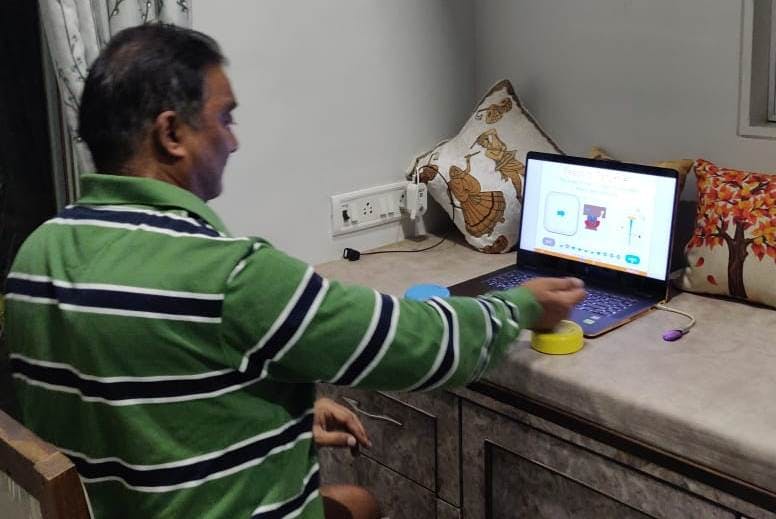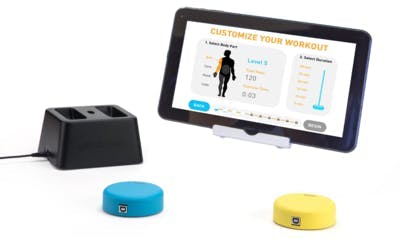Paraplegia is a medical term that refers to paralysis of the lower limbs as a result of damage to the spinal cord. Complete paraplegia occurs when the damage to the spinal cord is severe enough to completely cut off all connections between the brain and areas below the level of injury.
Individuals with complete paraplegia will have no motor control or feeling below their level of injury. Luckily, they will have full control of their arms, so they can still perform many activities of daily living on their own.
To help you understand what to expect with complete paraplegia, this article will go over the following topics. If you’d like to jump to a specific section, click on the links below:
- What Causes Complete Paraplegia?
- Is Recovery from Complete Paraplegia Possible?
- Can Complete Paraplegia Transition into Incomplete Paraplegia?
- Complications of Complete Paraplegia
- Treatments for Complete Paraplegia
What Causes Complete Paraplegia?

Complete paraplegia is caused by damage to the thoracic, lumbar, or sacral regions of the spinal cord. Individuals with thoracic level injuries will also experience paralysis in the trunk, which can affect balance.
The higher your level of injury, the more functions will be affected. For example, someone with a T7 spinal cord injury may experience paralysis from the waist down while someone with an L4 SCI may experience paralysis in certain parts of their legs. This is because messages from the brain cannot get past the site of injury.
When a lesion is complete, individuals will not have any spared neural pathways. Spared neural pathways describe undamaged connections in the spinal cord. They play an essential role in recovery because they’re capable of adapting and learning new functions.
When no spared neural pathways exist, communication between the brain and areas below the level of injury cannot occur. As a result, all functions below the level of injury will be affected.
Learn more about what functions are affected at each level of spinal cord injury»
In the following section, we’ll discuss what can be done to promote recovery after a complete SCI.
Is Recovery from Complete Paraplegia Possible?
Damaged neurons in the spinal cord are not able to regenerate, which makes recovery from a complete SCI limited. However, that does not mean you cannot improve.
Through rehabilitative therapies like physical therapy, occupational therapy, and psychotherapy, individuals with complete paraplegia can learn how to adapt and emotionally cope.
In physical therapy, individuals will work on improving their mobility through exercises designed to maintain full range of motion in the joints, promote circulation, and minimize the effects of muscle atrophy.
Occupational therapy will help individuals with complete paraplegia learn new ways to perform activities of daily living like grooming, transferring, and feeding. This will help ease the transition back to everyday life.
While there are physical limitations associated with complete paraplegia, individuals can always work on improving their mental health. Due to the change in lifestyle, depression, and anxiety commonly occur after spinal cord injuries. Learning how to effectively cope through psychotherapy can significantly improve your quality of life.
Can Complete Paraplegia Transition into Incomplete Paraplegia?

While anatomically complete spinal cord injuries cannot become incomplete, it is fairly common for individuals to mistake incomplete SCIs for a complete one.
Many patients think they have complete SCIs when in fact, they’re in spinal shock. Spinal shock is a temporary condition that results in loss of reflexes and control below your level of injury.
Inflammatory responses that occur immediately after a spinal cord injury can cause excessive swelling, which significantly reduces blood flow and prevents optimal functioning of the spinal cord.
Luckily, this hostile microenvironment in the spinal cord does calm down. Once the swelling starts to reduce, functions can gradually return. Even those with complete spinal cord injuries tend to regain about 2 levels of injury once spinal shock dies down.
In the following section, we’ll discuss complications that can occur as a result of complete paraplegia.
Complications of Complete Paraplegia
Due to paralysis of the lower body, individuals with complete paraplegia may experience a variety of complications.
Common complications of complete paraplegia include:
- bowel and bladder dysfunction
- sexual dysfunction
- inability to walk
- muscle atrophy (muscle shrinking)
- osteoporosis (low bone density)
- musculoskeletal pain from increased dependence on the arms
- pressure sores
Individuals with complete paraplegia will have long-term paralysis, so it’s essential to learn how to properly manage complications.
Up next, we’ll discuss potential treatments for complete paraplegia.
Is There a Treatment for Complete Paraplegia?

Because damaged neurons in the spinal cord are not capable of regeneration, the recovery outlook for complete paraplegia is limited.
However, there are some promising treatments that suggest a brighter future for individuals with complete spinal cord injuries.
Electric Epidural Stimulation
Although still in clinical trials, epidural stimulation has enabled patients with complete paraplegia to walk again.
By surgically inserting a stimulator onto the spine, electric currents can excite the neurons below the injury and promote movement. The electric currents act like brain signals and tell the body to react.
Epidural stimulation won’t treat damage to the spinal cord. Instead, it works around the spinal cord damage to activate healthy neurons below the level of injury.
Stem Cell Therapy
Another promising treatment for complete paraplegia is stem cell therapy. It involves inserting stem cells into the spinal cord to promote tissue regeneration.
Stem cells can divide infinitely and can turn into many different cell types. Rather than working around the injury, stem cell therapy focuses on repairing the lesion and promoting nerve regrowth.
However, the spinal cord doesn’t heal as easily as the rest of the body. Researchers are currently working on ways to prevent scarring that limit stem cells from promoting nerve regeneration.
Exoskeletons
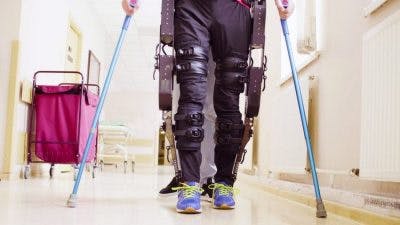
Exoskeletons are wearable technology that can help individuals with complete paraplegia get on their feet again. By shifting your weight toward, the sensors in the exoskeleton will facilitate movement of the legs.
While exoskeletons will not heal nerve damage or promote active movement, they will help get the legs moving, which will increase circulation and reduce muscle atrophy.
Learn more about exoskeletons for paraplegics»
Physical Therapy
Potential treatments like epidural stimulation and stem cell transplants are not effective unless participants also utilize intensive physical training to re-learn how to walk again.
Similarly, physical therapists will teach individuals with complete paraplegia how to maintain circulation in their lower bodies through passive movement.
Continuing to move paralyzed limbs is essential to prevent blood from pooling in the legs, muscle atrophy, osteoporosis, and pressure sores.
Understanding Complete Paraplegia: Key Points
Living with complete paraplegia can be overwhelming but with the right mindset and support, you can overcome limitations.
Especially because complete paraplegia does not affect the arms or speech, individuals can continue to live independent and productive lives.
Similarly, there are many promising treatments being researched that suggest a positive future for complete paraplegia recovery.
Hopefully, this article helped you understand what complete paraplegia is and what to expect in the rehabilitation process. Good luck!

